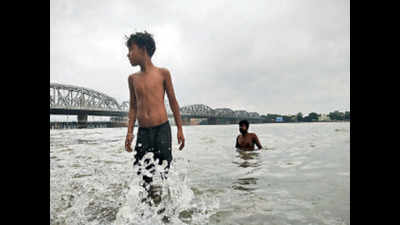- News
- City News
- kolkata News
- Hooghly water unfit for bathing, Dakshineswar worst: Study
Trending
This story is from March 1, 2020
Hooghly water unfit for bathing, Dakshineswar worst: Study
Water in the 17 rivers monitored by the state pollution control board (PCB) do not meet the bathing standard, putting several lakh who live along the rivers and bathe there at risk. The worst-hit area is Dakshineswar that attracts 50,000 devotees daily. Of the 44 locations where water quality was tested, Dakshineswar has the worst biochemical oxygen demand (BOD) level, implying that the pollution load is so high that it is difficult for even fish to breathe in the water here.

A boy bathes in the Hooghly off the Dakshineswar temple ghat
KOLKATA: Water in the 17 rivers monitored by the state pollution control board (PCB) do not meet the bathing standard, putting several lakh who live along the rivers and bathe there at risk. The worst-hit area is Dakshineswar that attracts 50,000 devotees daily. Of the 44 locations where water quality was tested, Dakshineswar has the worst biochemical oxygen demand (BOD) level, implying that the pollution load is so high that it is difficult for even fish to breathe in the water here.
None of 14 monitoring locations along the Ganga, five in the Himalaya and north, 19 in the west, including 10 locations at Damodar and six in the upper and lower Ganga delta rivers currently meet the bathing standard (5mg/litre dissolved oxygen; 3ml/litre biochemical oxygen demand and 500MPN/100ml coliform bacteria) revealed a report prepared by NGO Legal Initiative for Forest and Environment (LIFE) after analysing the water quality data compiled by PCB.
Admitting that the rivers were choking and needed a break from the untreated sewage flowing into them, PCB chairman Kalyan Rudra said the watchdog agency’s target was to ensure that water in rivers improves to achieve the bathing standard.
Rudra said water in the rivers are now a lot more polluted than when the classifications were done a couple of decades ago. “The ecological flow of the rivers, or their ability to flush the sediment load and dilute pollutants has since reduced. We have to stop flow of further drainage into rivers,” he said.
None of 14 monitoring locations along the Ganga, five in the Himalaya and north, 19 in the west, including 10 locations at Damodar and six in the upper and lower Ganga delta rivers currently meet the bathing standard (5mg/litre dissolved oxygen; 3ml/litre biochemical oxygen demand and 500MPN/100ml coliform bacteria) revealed a report prepared by NGO Legal Initiative for Forest and Environment (LIFE) after analysing the water quality data compiled by PCB.
TimesView
A concerted approach involving upstream states, where many of bigger river systems originate, is necessary. Many of our rivers are still used as sewerage systems and this must stop.
Admitting that the rivers were choking and needed a break from the untreated sewage flowing into them, PCB chairman Kalyan Rudra said the watchdog agency’s target was to ensure that water in rivers improves to achieve the bathing standard.
The report has also pointed out discrepancies in activities recorded by the watchdog agency and classification of rivers. “Designating the right use-based classification is a prerequisite for curbing pollution as the permissible limit of separate parameters is different for each class. For example, the level of total coliform (TC) needs to be brought down to 500 MPN (most probable number)/100ml if the water has to be made suitable for ‘Class B’(outdoor bathing). For ‘Class C’, or water that can be made fit for drinking with conventional treatment, the TC can remain at 5,000MPN/100ml. A higher level of TC indicates the presence of disease-causing organisms (pathogens),” said LIFE analyst Kankana Das.
Rudra said water in the rivers are now a lot more polluted than when the classifications were done a couple of decades ago. “The ecological flow of the rivers, or their ability to flush the sediment load and dilute pollutants has since reduced. We have to stop flow of further drainage into rivers,” he said.
End of Article
FOLLOW US ON SOCIAL MEDIA










